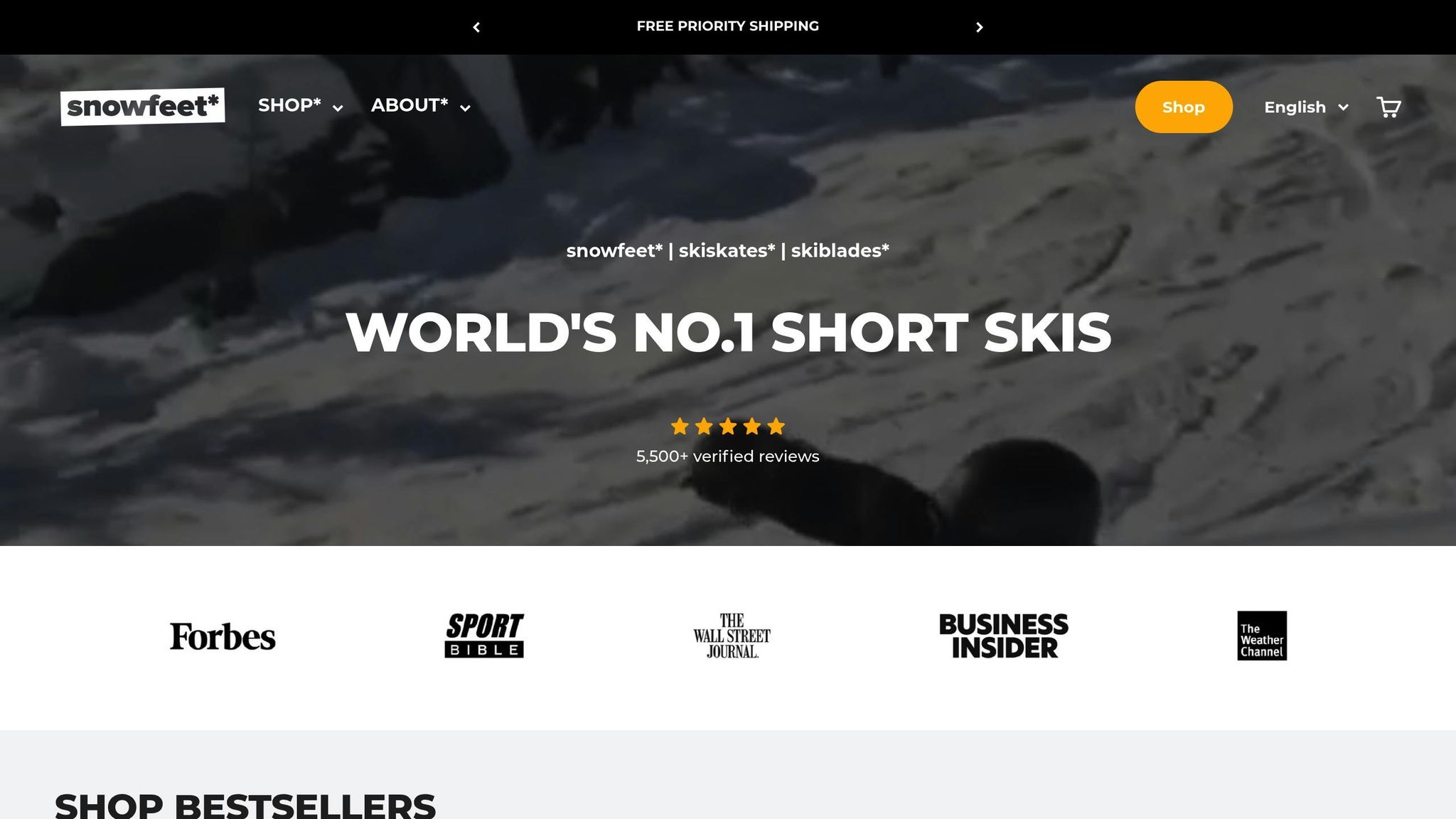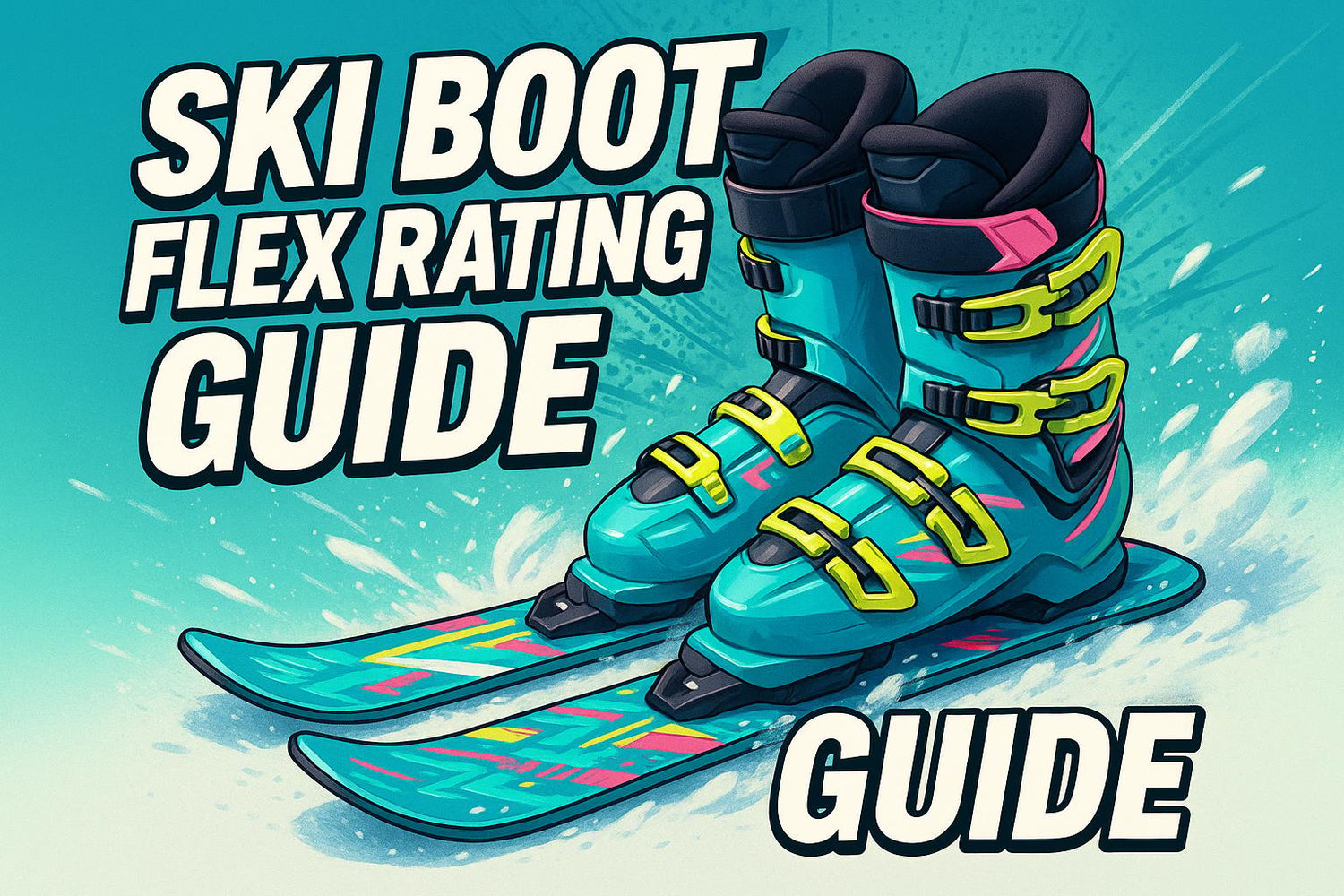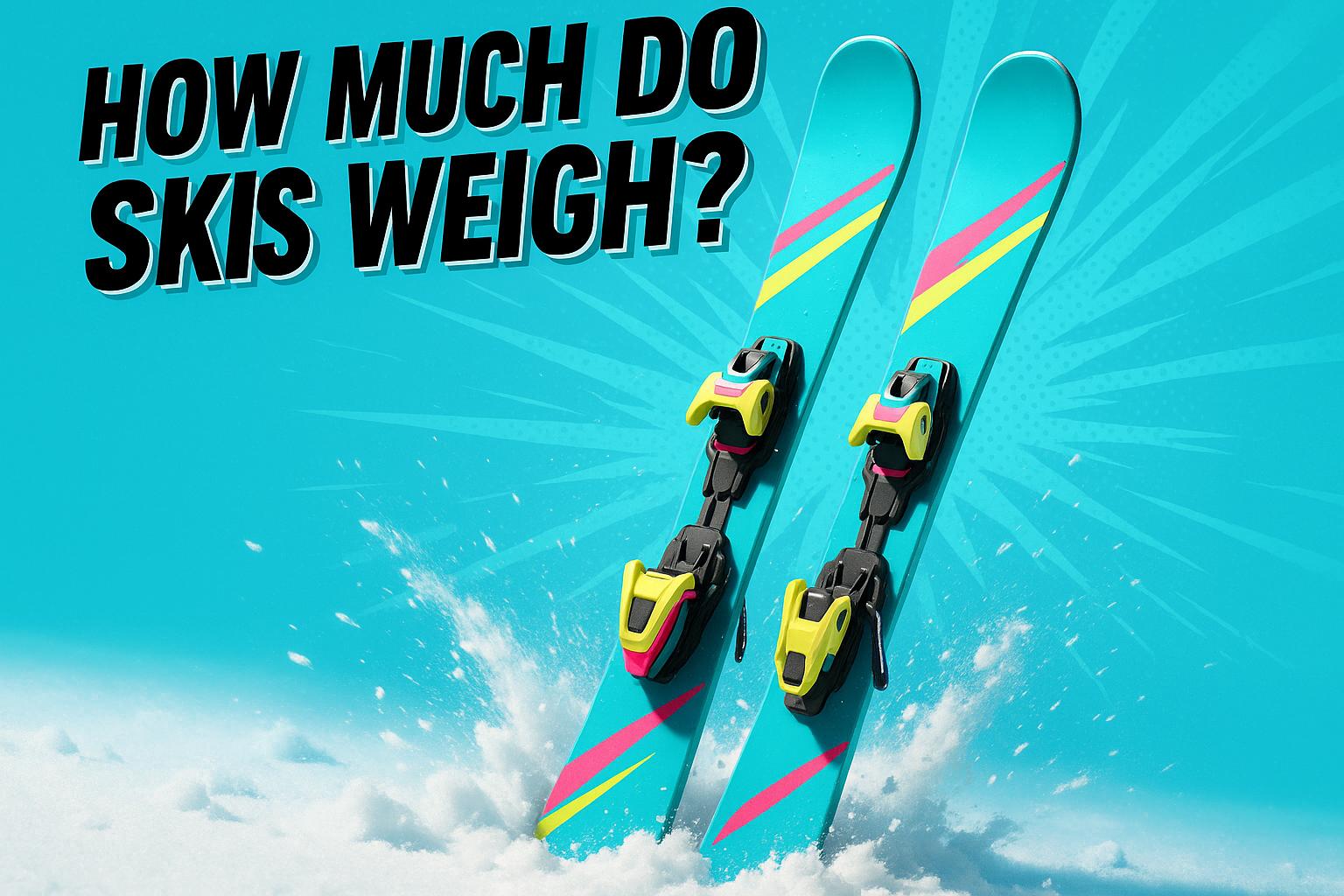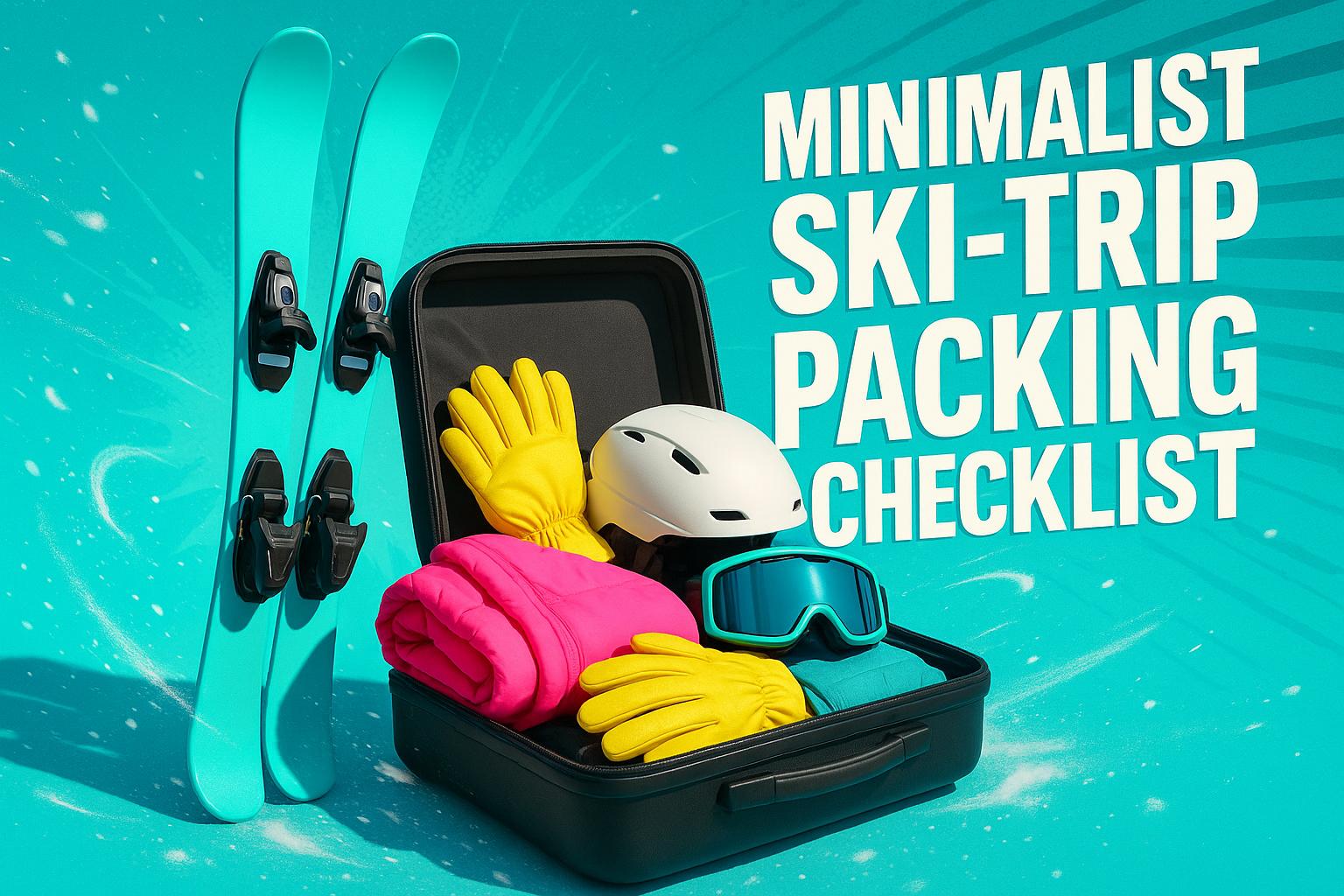Finding the right ski boot flex is essential for control, comfort, and performance - especially if you ride short skis like Snowfeet*. Short skis respond faster to movements, which makes matching your boot flex to your skiing style and weight even more important. Here's a quick breakdown:
- What is Ski Boot Flex? It measures how stiff or soft a boot is when you lean forward. Flex ratings range from 50 (soft) to 130+ (stiff).
- Why Flex Matters for Short Skis: Short skis are highly responsive, so the wrong flex can lead to poor control or fatigue.
-
Flex Recommendations by Skill Level:
- Beginners: Softer boots (60–80 flex for women, 80–110 for men).
- Intermediate: Medium flex (80–90 for women, 100–120 for men).
- Advanced: Stiffer boots (90–120+ for women, 120+ for men).
- Boot Options for Snowfeet*: Snowfeet* gear works with ski boots, snowboard boots, and winter shoes, offering flexibility based on your needs and comfort.
Quick Comparison: Boot Flex for Short Skis
| Flex Rating | Skill Level | Best For | Comfort | Control |
|---|---|---|---|---|
| Soft (50–70) | Beginner | Easy turns, casual skiing | High | Low |
| Medium (70–100) | Intermediate | Groomed runs, varied terrain | Medium | Medium |
| Stiff (90–130+) | Advanced | Aggressive, high-speed skiing | Low | High |
Key Tip: Match your boot flex to your weight, height, and skiing style for the best experience. Snowfeet*’s compatibility with various boots makes it easier to find the perfect setup for comfort and performance.
How Flex Ratings Affect Performance with Short Skis
Control and Response
When it comes to short skis like Snowfeet* Skiblades and Skiskates, the flex rating of your boots plays a huge role in how much control and responsiveness you’ll experience. Unlike longer skis from brands like Rossignol or Atomic, which can mask some flex mismatches with their larger surface area, short skis - typically between 75 cm and 110 cm - magnify every movement you make. This means that the flex of your boots directly impacts how the skis respond to your inputs, making it a critical factor in performance.
For beginners or lighter skiers, softer flex boots (rated 60–80) are often the go-to choice. They allow for easier turn initiation and smoother maneuverability, which is perfect for carving or making quick direction changes. This setup can also be a game-changer for freestyle skiing or navigating terrain parks, where agility and comfort are key.
On the other hand, advanced skiers who crave speed and precision often lean toward stiffer flex boots (90–130+). With short skis, these boots enhance stability and make every movement on the snow feel sharp and immediate. This setup is ideal for executing aggressive turns with little effort, giving experienced riders the control they need to push their limits.
The key takeaway? With short skis, finding the right balance in boot flex is essential. Too stiff, and you’ll lose fluidity; too soft, and you’ll sacrifice precision. This precision requirement naturally leads to the next consideration: how your boot choice impacts not just performance but also comfort.
Comfort and Boot Options
One of the standout perks of Snowfeet* products is the flexibility they offer in boot choices - something you don’t get with traditional ski setups. Unlike standard skis, which often require specific boot models, Snowfeet* gear works with winter shoes, snowboard boots, and ski boots. This versatility means you can prioritize comfort without compromising performance.
But here’s the catch: energy transfer efficiency is closely tied to the flex rating of your boots. If the flex is too stiff, your muscles have to work overtime to make quick adjustments, especially since short skis demand constant movement. On the flip side, a boot that’s too soft can make it harder to maintain control, leading to extra effort and, ultimately, muscle fatigue during long sessions.
For casual riders or those planning to spend hours on the slopes, softer flex boots are often a more comfortable option. They’re forgiving and less demanding on your legs, though they might not be as responsive. This makes them a great choice for laid-back runs or varied terrain where comfort matters more than split-second precision.
If you’re an aggressive skier or someone who prioritizes performance over comfort, stiffer flex boots are the way to go. They offer better energy transfer and sharper responsiveness, though they can feel less forgiving on your feet. Thankfully, with Snowfeet’s compatibility across various boot types, you’re not locked into uncomfortable gear just to get the flex rating you need.
Your weight and build also play a role in choosing the right flex. Softer boots are generally better for lighter individuals or those who prefer a relaxed riding style. Meanwhile, stiffer boots are better suited for taller, heavier, or stronger skiers who want more aggressive performance. With Snowfeet’s adaptable boot options, you can tailor your setup to match both your physical needs and comfort preferences.
This combination of boot flexibility and the natural responsiveness of short skis creates a setup that’s not just high-performing but also comfortable - a balance that’s hard to find with traditional ski gear.
Choosing the Right Flex Rating for Your Skill Level and Terrain
Flex Ratings by Skill Level
When it comes to short skis like Snowfeet* products, your skill level plays a huge role in picking the right boot flex. Why? Short skis magnify every movement, so having the right flex can make or break your experience on the slopes.
For beginners, softer boots are the way to go. Women should aim for a flex rating between 60 and 80, while men will find 80 to 110 more forgiving. Softer boots make it easier to turn and provide the flexibility you need while learning the ropes. Plus, Snowfeet* gear pairs well with these boots, making the learning process more accessible.
If you're an intermediate skier, you'll need boots that offer more control without sacrificing comfort. For women, a flex range of 80–90 works well, and for men, 100–120 is ideal. This level of flex gives you the responsiveness needed for steeper slopes and variable snow conditions, while still being comfortable for longer sessions. Snowfeet* Skiblades and Skiskates shine here, offering a great balance of precision and ease.
Advanced and expert skiers, on the other hand, need stiffer boots to match their aggressive style. Women in this category typically go for a flex rating of 90–120, while men often need 120 or higher. If you're taller or stronger, it might be worth stepping up to an even stiffer boot for added support and responsiveness.
But skill level isn’t the only factor - terrain matters too.
Terrain-Based Recommendations
The type of terrain you’re tackling can fine-tune your boot flex choice even further.
For groomed runs, medium flex boots in the 70–100 range are a solid pick. They strike a great balance between comfort and responsiveness, making them perfect for carving on hard-packed snow. They also help reduce fatigue, which is a big win on long ski days. Snowfeet* products thrive in these conditions, thanks to their nimble design.
If you’re hitting the terrain park or freestyle areas, softer boots (50–80 flex) are your best bet. They’re more forgiving, which is a big plus when you’re landing tricks or need extra maneuverability. Snowfeet* gear works particularly well here, offering flexibility that enhances performance without sacrificing comfort.
For powder or ungroomed terrain, you’ll want stiffer boots in the 90–130 range. They provide the control and power you need to handle deeper snow. If you’re venturing into backcountry or hiking terrain, your choice of boot flex becomes even more critical. Snowfeet*’s compatibility with different winter footwear gives you options - go with a softer flex for casual exploration or a stiffer boot for tackling more technical terrain.
Matching your boot flex to both your skill level and the terrain you ride is essential. If you’re mostly sticking to groomed runs but occasionally dabble in the park, a softer, medium flex boot might be your best choice. All-mountain skiers who face a mix of conditions could even consider keeping multiple boot options on hand - a convenience made easier by Snowfeet*’s versatile compatibility.
Comparing Snowfeet* Boot Compatibility to Standard Ski Brands

Key Differences Between Snowfeet* and Standard Ski Brands
When you stack Snowfeet* products against traditional ski brands like Rossignol, Atomic, Head, and Elan, the contrast in boot compatibility is hard to miss. Snowfeet* gear works with your regular winter boots, cutting out the need for specialized alpine boots. This makes them a much more flexible option for winter sports enthusiasts.
Boot Requirements and Flexibility
With traditional skis, you’re locked into using alpine boots that fit specific DIN bindings. These boots don’t come cheap and are a must-have for most setups. Snowfeet*, on the other hand, uses adjustable bindings (available in Basic, Standard, and Pro X models) that work with a range of everyday footwear. This means you can skip the hefty investment in specialized boots and still hit the slopes comfortably.
Cost and Accessibility
Let’s face it - traditional ski equipment can burn a hole in your wallet. Between the skis, bindings, and boots, the costs add up fast. Snowfeet* flips the script by offering a more budget-friendly option. For instance, you can grab a pair of Mini Ski Skates for as little as $150. That’s an affordable way to dive into winter sports without committing to the high costs of traditional setups.
Portability and Convenience
Here’s another win for Snowfeet*: portability. Their compact design makes them super easy to carry around. Skiskates, for example, are only 44 cm long, so you can toss them in your backpack and go. Compare that to traditional ski gear, which often requires bulky bags and a spacious car just to get to the slopes. With Snowfeet*, you can easily use public transportation or pack light for your trip.
Performance and Comfort Trade-offs
Traditional alpine boots are all about performance. Their rigid design helps with power transfer on downhill runs, but they can be stiff and uncomfortable when you’re not skiing. Snowfeet* takes a different approach. Their flexible bindings let you move around easily, whether you’re walking through the lodge or climbing stairs. No more clunky, awkward movements off the slopes.
Versatility in Use
Traditional skis are usually at their best on groomed slopes or in resort settings. Snowfeet* gear, however, is built for a variety of conditions. Whether you’re tackling slopes, snowparks, hiking trails, or even just playing in your backyard, Snowfeet* delivers. Their compatibility with everyday winter boots means you’re not tied down by the limitations of alpine boots, giving you the freedom to explore wherever the snow takes you.
These differences highlight why Snowfeet* might be the better choice for those looking for flexibility, affordability, and ease of use in their winter sports gear.
sbb-itb-17ade95
Practical Flex-Selection Tips for Snowfeet* Users
Factors to Consider When Choosing Flex
Picking the right boot flex is all about matching it to your body and skiing style. One key factor? Your weight. Heavier skiers usually need stiffer boots for proper support, while lighter skiers can achieve the same performance with softer flex ratings.
Height plays a role too. Taller skiers naturally generate more leverage when leaning forward, which often calls for stiffer boots to maintain control. If you’ve got good ankle flexibility, you might also find stiffer boots easier to handle.
Then there’s your skiing style. Are you the type to charge down steep slopes, or do you prefer a laid-back cruise? Aggressive skiers, who demand a lot from their gear, typically need stiffer boots for better power transfer and control. On the flip side, if you’re more into casual skiing, softer boots offer a more forgiving and comfortable ride.
But here’s the catch: a boot that’s too soft can collapse under your weight, leading to excessive knee bend and fatigue. Too stiff, and you’ll feel restricted, with your weight shifting backward, making it harder to control your movements.
Here’s a quick flex rating guide to help you out:
| Flex Rating | Men's Rating | Women's Rating | Ability Level |
|---|---|---|---|
| Soft | 50–70 | 40–60 | Beginner |
| Medium | 70–90 | 40–60 | Intermediate |
| Medium/Stiff | 80–100 | 70–80 | Advanced Intermediate |
| Stiff | 90–110 | 80–90 | Advanced |
Once you’ve nailed down the right flex, make sure your boots are a perfect match for Snowfeet* systems.
Making Sure Your Boots Work with Snowfeet*
After figuring out your ideal flex, the next step is ensuring your boots are compatible with Snowfeet*. One of the great things about Snowfeet* is their versatility - they work with various boot types, offering more options than traditional ski setups. Depending on the model, you can use snowboard boots, ski boots, or even winter shoes.
For those with US sizes 6 and below, snowboard boots tend to provide the snug and secure fit you’ll need. If your size falls between 6 and 13, you’ve got more flexibility in your choices. Snowfeet* Mini, specifically, fits EU sizes 27–38.
No matter what type of boot you go with, ankle support is critical. A snug fit around your ankle ensures stability and control, which is especially important for short skis where movements are quicker and more frequent. Snowboard boots are a solid choice for tricks and casual riding, thanks to their flexibility and comfort. Ski boots, on the other hand, offer more stability and might feel more familiar if you’re used to traditional alpine equipment. And if you’re planning a hike or some sledding, winter shoes are a practical and comfortable option.
Before hitting the slopes, test your setup at home. Adjust your bindings for a secure and comfortable fit. Snowfeet* bindings (available in Basic, Standard, and Pro X models) are adjustable to accommodate different boot types, so take some time to dial them in. Make sure your boots stay firmly in place and that you can flex forward without feeling restricted.
Finally, think about how you’ll be using your Snowfeet*. If you’re heading to the snowpark for tricks, snowboard boots are a great pick for their flexibility. For more aggressive downhill action, ski boots provide the stability and power transfer you’ll want. And if your plans include casual fun or mixed terrain, sturdy winter boots could be your best bet.
The beauty of Snowfeet*? You’re not locked into just one type of boot, unlike traditional ski setups. Feel free to experiment with different combinations to find what suits your style, terrain, and comfort the best.
What ski boot flex is best, how it works, and misconceptions explained.
Conclusion: Finding Your Perfect Ski Boot Flex
Choosing the right ski boot flex comes down to balancing your weight, skill level, and riding style. For beginners, a softer flex makes turning and learning much easier. On the other hand, experienced skiers might prefer a stiffer flex for better power transfer and control.
When it comes to versatility, Snowfeet* products truly shine. Unlike traditional ski gear from brands like Rossignol or Atomic, Snowfeet* simplifies the experience. They offer an affordable and flexible alternative without sacrificing performance, making them a standout choice for a variety of conditions.
The feedback speaks for itself. Snowfeet* products consistently receive stellar ratings - between 4.9 and 5.0 stars - based on thousands of reviews. Users love the ease of use and the pure joy they bring to the slopes. As Snowfeet* founder Zbyněk explains:
"I love how easy it is to put snowboard boots on and walk with them, they don't hurt like ski boots, and I feel more flexible during the ride."
Another advantage? Many ski boots now include adjustable flex settings. This feature allows you to tweak your setup as your skills grow or when you venture into different terrains.
Short skis, like Snowfeet*, also bring their own set of perks. They’re naturally more forgiving than traditional long skis, making them a great fit for terrain parks where a medium to soft flex helps with maneuverability and absorbing impacts. Whether you're carving down groomed trails, hiking in snowy landscapes, or just having fun in your backyard, finding the right flex can make every ride smoother and more enjoyable.
With this guide, you’re ready to fine-tune your setup for peak performance. Choose the flex that matches your style, pair it with Snowfeet*, and discover the agility and fun that only short skis can deliver.
FAQs
How do I choose the right ski boot flex for my weight and skiing style when using Snowfeet products?
Choosing the right ski boot flex for Snowfeet products comes down to a few key factors: your weight, skiing style, and the type of terrain you plan to conquer. Flex ratings usually range from soft (60) to very stiff (130), and finding the right one can make all the difference in your comfort and control on the slopes.
For lighter skiers or those using shorter skis like Snowfeet, a softer flex (60–80) is a solid choice. It’s easier to control, helps with smoother turns, and feels more comfortable - making it ideal for beginners or anyone skiing casually.
If you’re on the heavier side or lean toward a more aggressive skiing style, a medium to stiff flex (80–100) might be your best bet. This range provides better stability, quicker response, and improved handling when you’re pushing the limits on speed or tackling tougher terrain.
Snowfeet products are designed with versatility in mind, making them a forgiving yet capable option. They strike a nice balance between comfort and performance, especially when compared to traditional ski brands like Rossignol or Atomic. The key is to match your boot flex with your personal skiing style and goals to ensure the best experience out there.
What makes Snowfeet products more affordable and convenient than traditional skis?
Snowfeet products offer a wallet-friendly and hassle-free alternative to traditional ski gear. With prices ranging from $150 to $690, they’re a far cry from the hefty price tag of traditional skis, which can run anywhere between $400 and $1,200. For anyone keeping an eye on their budget, this opens up winter sports to a lot more people.
Another big win? Their portability. Snowfeet are compact and lightweight, making it easy to toss them in a backpack - no need for those clunky ski bags or pricey roof racks. This means lower transportation costs and way less stress when traveling. Even better, you can use Snowfeet with your regular winter boots, sparing you the expense of buying specialized ski boots. Talk about convenience!
In short, Snowfeet takes the complications out of skiing. They’re budget-friendly, easy to carry, and super accessible - ideal for anyone who wants to hit the slopes without the fuss of traditional gear.
Can I use my winter boots or snowboard boots with Snowfeet gear, and how will it affect my performance and comfort?
Yes, you can absolutely use your snowboard boots with Snowfeet gear, and they’re a solid pick for both comfort and performance. Snowboard boots tend to be more flexible than traditional ski boots, giving you better ankle mobility. This extra flexibility is a big plus for activities like skiskating and other quick, dynamic movements, making them a great match for short skis like Snowfeet.
Snowfeet’s adjustable bindings are built to fit most snowboard boots snugly, offering solid stability and control on the slopes. Pairing your snowboard boots with Snowfeet means you’ll get a more comfortable and responsive ride - whether you’re cruising casually or tackling more adventurous terrain.


































Leave a comment
This site is protected by hCaptcha and the hCaptcha Privacy Policy and Terms of Service apply.